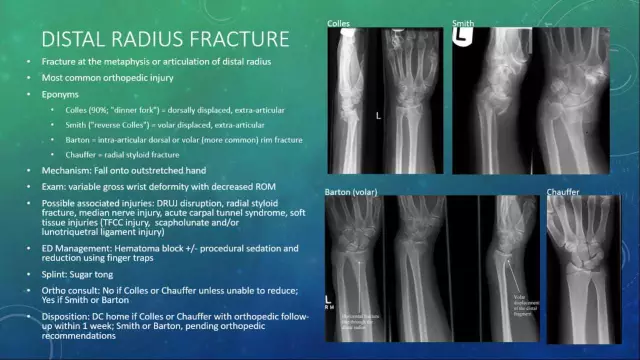- Author Curtis Blomfield [email protected].
- Public 2023-12-16 20:44.
- Last modified 2025-01-23 17:01.
The human forearm is made up of tubular long bones. There are two in total. The forearm contains the ulna and radius. They are bent so that, being close, they are connected only by their ends. Throughout its length, there is space between them. The ulna and radius include the body (diaphysis) and ends (epiphyses). On the epiphyses are the articular surfaces.
Through some articular surfaces, a connection with the humerus is made. Others are designed to articulate with the wrist segments.
The ulna and radius have a trihedral shape along their length. There are three edges and three surfaces. One surface is directed forward, the second - backward. The third - at the ulna - inside, and at the radius - outwards.
Of all three edges, one is sharp. It separates the posterior and anterior surfaces, facing the adjacent bone, limiting the space between the bones. In this regard, it has another name - the interosseous edge.
It should be noted that the components of the forearm skeleton, in addition to common features, also have distinctive features.
So, the radius is located on the outside of the forearm. The lower epiphysis of this segment is moremassiveness. At the upper end is the head of the bone. It has a small indentation. The edge of the head has an articular circumference.
Just below the head is the neck. The radius is also endowed with a special tuberosity - the place of attachment of the biceps brachialis.
The radius has a slightly wider lower end. There is a notch on the inside. The ulna goes into it.
On the opposite side there is a styloid process going down. The lower surface has a concave carpal articular surface. With the help of a protrusion, it is divided into two sections for the lunate and navicular bones.

In trauma practice, there are various injuries of the bones of the forearm. Among them, experts distinguish more or less common. So, as a result of a direct (hit on the forearm) or indirect (fall on the arm) injury, a diaphyseal fracture can occur in both bones of the forearm. In this case, small fragments of segments are formed, the position of which can change. Due to the contraction of the membrane located between the bones, the fragments, as a rule, approach each other.
Fracture of the radius with displacement is characterized by some shortening of the forearm. The patient supports the injured limb with a he althy hand. The mobility of the fragments provokes a sharp pain at the moment of probing the area, lateral compression of the forearm area remote from the injury site and under axial load.

When falling on an outstretched hand, as a rule, a fracture of the head of the radius occurs. In this case, pain appears in the area of the elbow joint, swelling occurs, it is difficult for the patient to move the limb. Due to the fact that this type of damage includes several types, an X-ray examination is necessary to establish an accurate diagnosis.






